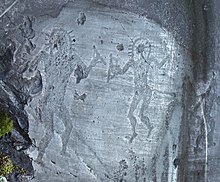
Back الأسطورة في بوابة النجوم Arabic Mytologie Hvězdné brány Czech فرلینگ Persian Vocabulaire de Stargate French A Csillagkapu-sorozatokban szereplő fajok Hungarian Jaffovia Slovak Yıldız Geçidi mitolojisi Turkish Міфологія всесвіту Зоряних брам Ukrainian

The mythology of the Stargate franchise is a complex and eclectic fictional backstory, which is presented as being historical, of the Stargate premise. A "rich mythology and world-building" are used to establish "a vast cosmology and an interesting alternate take on the history of Earth";[1] a defining feature is "its use of ancient mythology, with stories that take inspiration from multiple places around the globe".[2] Narratives center around xeno-mythology as experienced by humans during episodic contact with alien races. Audiences across a variety of platforms - including TV series, novels, comics and movies - witness the people of Earth exploring a fictional universe using the Stargate. Species established early on in the franchise recur throughout, with one adversary often dominating a particular story arc, which can continue across several seasons.
In addition to a diversity of alien life, the Stargate universe includes an abundance of humans who, prior to the events depicted in the various Stargate fictional vehicles, have been scattered across the cosmos by advanced aliens. Some of the most significant species or beings in Stargate SG-1 are the Goa'uld, the Asgard, and the Replicators. Stargate Atlantis, set in the Pegasus Dwarf Irregular Galaxy, introduced the Wraith and the Asurans. One of the most influential species in Stargate, the Ancients, are revealed to have moved on to a higher plane of existence. "There’s no shortage of familiar myths to be found in the Stargate franchise, even if they are transformed to fit sci-fi parameters."[2]

Frederic Krueger notes the re-emergence of the Ancient Astronaut Discourse (AAD) in the 1990s, and points to "the continuous mutual influence between the AAD and popular culture, exemplified via the rather spectacular case of Stargate".[3] For example, an origin theory for human populations shown to inhabit the Milky Way galaxy in Stargate SG-1 holds that the Goa'uld transplanted humans from Earth to other planets for slave labor. Many of these populations were abandoned, often when deposits of the fictional precious mineral naquadah were exhausted, and subsequently developed their own unique societies.[S 1]
Some of these extraterrestrial human civilizations are shown to have become much more technologically advanced than those on Earth, the in-show rationale being that they never suffered the setback of the Dark Ages. The most advanced of these humans were the Tollan, who were destroyed by the Goa'uld in Season 5's Between Two Fires.[S 2] Another example of AAD in the mythos is the creation of human populations in the Pegasus galaxy by the Ancients,[S 3] few of which are technologically advanced, as the Wraith destroy any civilization that could potentially pose a threat.[S 4] Audiences are also made aware of large numbers of humans in the Ori galaxy, where human worship enhances the power of the Ori.[S 5]
- ^ Jay, Johnny (September 14, 2019). "Classic Sci Fi TV: Stargate SG-1 (1997)". Cancelled Sci Fi. Retrieved March 23, 2024.
- ^ a b Hynes, Annabel (February 9, 2023). "Stargate: How Does The Franchise Use Ancient Mythology?". GameRant.com. Retrieved March 22, 2024.
- ^ Krueger, Frederic (2017). "The Stargate Simulacrum: Ancient Egypt, Ancient Aliens, and Postmodern Dynamics of Occulture". Aegyptiaca. Journal of the History of Reception of Ancient Egypt. 1: 47–74.
Cite error: There are <ref group=S> tags on this page, but the references will not show without a {{reflist|group=S}} template (see the help page).